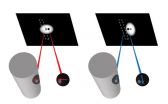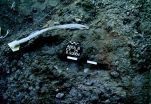(Press-News.org) Without better local management, the world's most iconic ecosystems are at risk of collapse under climate change, say researchers in a study published in the journal Science.
The international team of researchers say protecting places of global environmental importance such as the Great Barrier Reef and the Amazon rainforest from climate change requires reducing the other pressures they face, for example overfishing, fertilizer pollution or land clearing.
The researchers warn that localised issues, such as declining water quality from nutrient pollution or deforestation, can exacerbate the effects of climatic extremes, such as heat waves and droughts. This reduces the ability of ecosystems to cope with the impacts of climate change.
"Poor local management makes an ecosystem less tolerant to climate change and erodes its capacity to keep functioning effectively," says study lead author Professor Marten Scheffer from Wageningen University in the Netherlands.
The authors examined three UNESCO World Heritage Sites: Spain's Doñana wetlands, the Amazon rainforest and the Great Barrier Reef.
While many ecosystems are important to their local people, these ecosystems have a global importance--hence their World Heritage designation. For instance, the Amazon rainforest is a globally important climate regulator.
The Great Barrier Reef is threatened by ocean acidification and coral bleaching, both induced by carbon dioxide emissions. Local threats such as overfishing, nutrient runoff and unprecedented amounts of dredging will reduce the reef's resilience to acidification and bleaching.
"It's an unfolding disaster. The reef needs less pollution from agricultural runoff and port dredging, less carbon dioxide emissions from fossil fuels, and less fishing pressure. Ironically, Australia is still planning to develop new coal mines and expand coal ports, despite global efforts to transition quickly towards renewable energy," says co-author Professor Terry Hughes, director of the ARC Centre of Excellence for Coral Reef Studies at James Cook University.
"As a wealthy country, Australia has the capability and responsibility to improve its management of the reef," adds Professor Hughes.
Professor Scheffer says the three World Heritage sites play a critical role in maintaining global biodiversity.
"If these systems collapse, it could mean the irreversible extinction of species."
"UNESCO is concerned that Australia isn't doing enough to protect the Great Barrier Reef. It would be disastrous for the $6 billion reef tourism industry and Australia's reputation if they list the GBR as 'in danger.' We need to put science into action to prevent this from happening," urges Professor Hughes.
Co-author Professor Scott Barrett from Columbia University says the problem is one of incentives.
"These ecosystems are of value to the whole world, not only to the countries that have jurisdiction over them. It may be necessary for other countries to bring pressure to bear on these 'host' countries or to offer them assistance, to ensure that these iconic ecosystems are protected for the benefit of all of humanity," Professor Barrett says.
Above all, the paper raises awareness of the great opportunities for enhanced local action.
"Local management options are well understood and not too expensive. So there is really no excuse for countries to let this slip away, especially when it comes to ecosystems that are of vital importance for maintaining global biodiversity," says Scheffer.
INFORMATION:
Publication: "Creating a safe operating space for iconic ecosystems," Science 2015. Marten Scheffer, Scott Barrett, Stephen R. Carpenter, Carl Folke, Andy J. Green, Milena Holmgren, Terry P. Hughes, Sarian Kosten, Ingrid A. van de Leemput, Daniel C. Nepstad, Egbert H. van Nes, Edwin T.H.M. Peeters and Brian Walker
More information and interviews:
General:
Marten Scheffer, +31 641804880, Marten.Scheffer@wur.nl (The Netherlands)
Carl Folke, +46 8 673 95 00, carl.folke@beijer.kva.se (Sweden)
Stephen R. Carpenter, +1 608-338-6759 (c), 608-262-3014 (o), srcarpen@wisc.edu (United States)
Economic implications:
Scott Barrett, +1 646-300-1437, sb3116@columbia.edu (United States)
Great Barrier Reef:
Terry Hughes, +61 7 478 14000, terry.hughes@jcu.edu.au (Australia)
Amazon Rainforest:
Daniel C. Nepstad, +1 508-566-1963, dnepstad@earthinnovation.org (United States)
Doñana National Park:
Andy J. Green, +34 95 4466700, ajgreen@ebd.csic.es (Spain)
The 2014 chemistry Nobel Prize recognized important microscopy research that enabled greatly improved spatial resolution. This innovation, resulting in nanometer resolution, was made possible by making the source (the emitter) of the illumination quite small and by moving it quite close to the object being imaged. One problem with this approach is that in such proximity, the emitter and object can interact with each other, blurring the resulting image. Now, a new JQI study has shown how to sharpen nanoscale microscopy (nanoscopy) even more by better locating the exact ...
Sifting through the center of the Milky Way galaxy, astronomers have made the first direct observations - using an infrared telescope aboard a modified Boeing 747 - of cosmic building-block dust resulting from an ancient supernova.
"Dust itself is very important because it's the stuff that forms stars and planets, like the sun and Earth, respectively, so to know where it comes from is an important question," said lead author Ryan Lau, Cornell postdoctoral associate for astronomy, in research published March 19 in Science Express. "Our work strongly reinforces the theory ...
Researchers from Banner Alzheimer's Institute (BAI) have developed a new brain image analysis method to better track the progression of beta-amyloid plaque deposition, a characteristic brain abnormality in Alzheimer's disease, according to a study published in the March issue of the Journal of Nuclear Medicine. Investigators also believe this new approach may make it easier to evaluate investigational anti-amyloid treatments in clinical trials.
During the last decade, researchers have been using positron emission topography (PET) to assess amyloid plaque deposition in ...
A psychology study from The University of Texas at Austin sheds new light on today's standards of beauty, attributing modern men's preferences for women with a curvy backside to prehistoric influences.
The study, published online in Evolution and Human Behavior, investigated men's mate preference for women with a "theoretically optimal angle of lumbar curvature," a 45.5 degree curve from back to buttocks allowing ancestral women to better support, provide for, and carry out multiple pregnancies.
"What's fascinating about this research is that it is yet another scientific ...
WASHINGTON, March 19, 2015 -- It's a simple claim made on thousands of personal care products for adults and kids: hypoallergenic. But what does that actually mean? Turns out, it can mean whatever manufacturers want it to mean, and that can leave you feeling itchy. Speaking of Chemistry is back this week with Sophia Cai explaining why "hypoallergenic" isn't really a thing. Check it out here: http://youtu.be/lXh8bnqMOZs.
Speaking of Chemistry is a production of Chemical & Engineering News, a weekly magazine of the American Chemical Society. The program features fascinating, ...
The Canadian research community on high-temperature superconductivity continues to lead this exciting scientific field with groundbreaking results coming hot on the heels of big theoretical questions.
The latest breakthrough, which will be published March 20 in Science, answers a key question on the microscopic electronic structure of cuprate superconductors, the most celebrated material family in our quest for true room-temperature superconductivity.
This result is the product of a longstanding close collaboration between the University of British Columbia Quantum ...
Some 2.5 million years ago, early humans survived on a paltry diet of plants. As the human brain expanded, however, it required more substantial nourishment - namely fat and meat - to sustain it. This drove prehistoric man, who lacked the requisite claws and sharp teeth of carnivores, to develop the skills and tools necessary to hunt animals and butcher fat and meat from large carcasses.
Among elephant remains some 500,000 years old at a Lower Paleolithic site in Revadim, Israel, Prof. Ran Barkai and his graduate students Natasha Solodenko and Andrea Zupanchich of Tel ...
DENVER, March 23, 2015 -- Since HIV emerged in the '80s, drug "cocktails" transformed the deadly disease into a manageable one. But the virus is adept at developing resistance to drugs, and treatment regimens require tweaking that can be costly. Now scientists at the 249th National Meeting & Exposition of the American Chemical Society (ACS) are announcing new progress toward affordable drugs that could potentially thwart the virus's ability to resist them.
ACS, the world's largest scientific society, is holding the meeting here through Thursday. It features nearly 11,000 ...
Washington, D.C.--To combat global climate change caused by greenhouse gases, alternative energy sources and other types of environmental recourse actions are needed. There are a variety of proposals that involve using vertical ocean pipes to move seawater to the surface from the depths in order to reap different potential climate benefits. A new study from a group of Carnegie scientists determines that these types of pipes could actually increase global warming quite drastically. It is published in Environmental Research Letters.
One proposed strategy--called Ocean ...
What if there were a pill that made you more compassionate and more likely to give spare change to someone less fortunate? UC Berkeley scientists have taken a big step in that direction.
A new study by UC Berkeley and UC San Francisco researchers finds that giving a drug that changes the neurochemical balance in the prefrontal cortex of the brain causes a greater willingness to engage in prosocial behaviors, such as ensuring that resources are divided more equally.
The researchers also say that future research may lead to a better understanding of the interaction between ...



